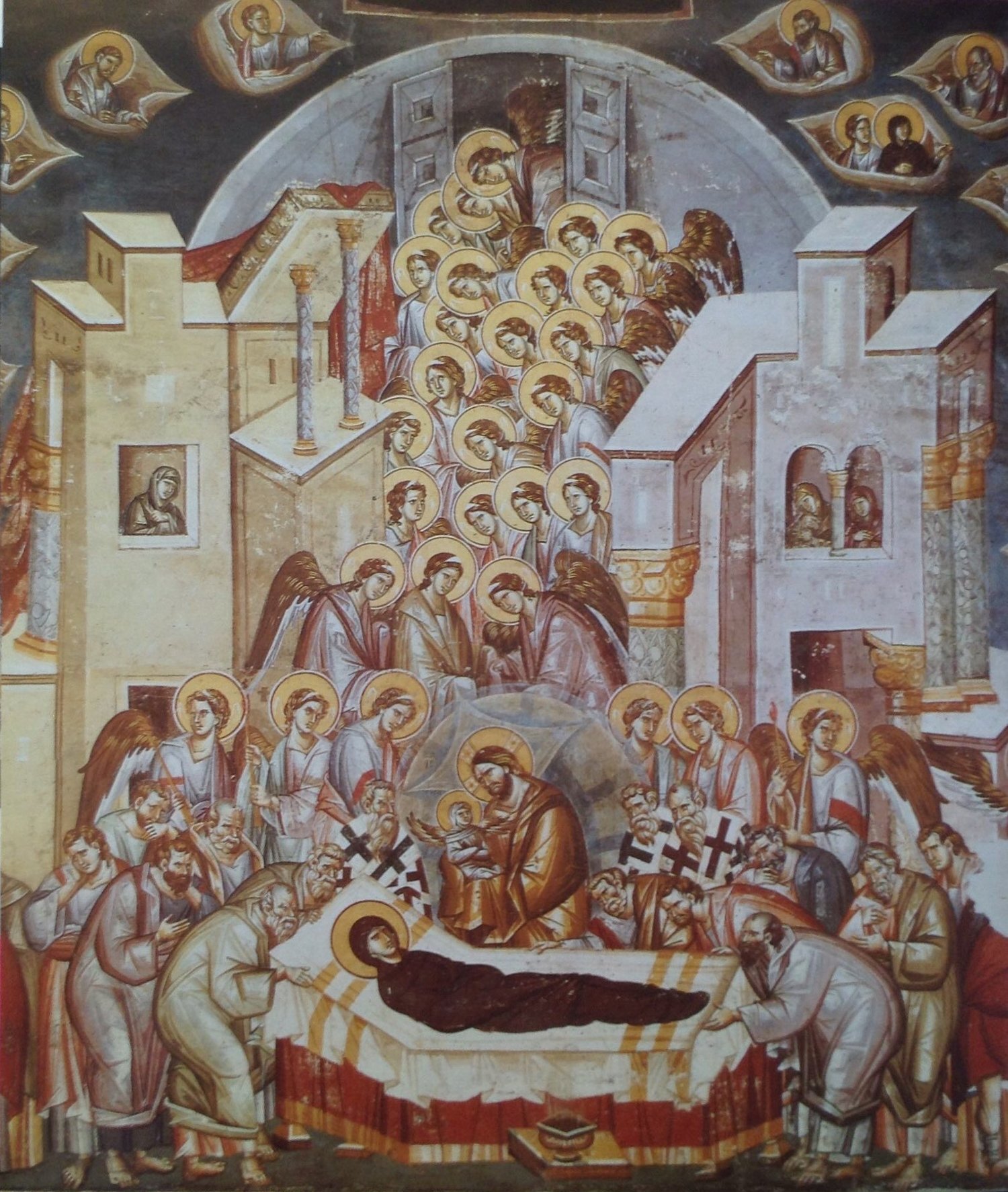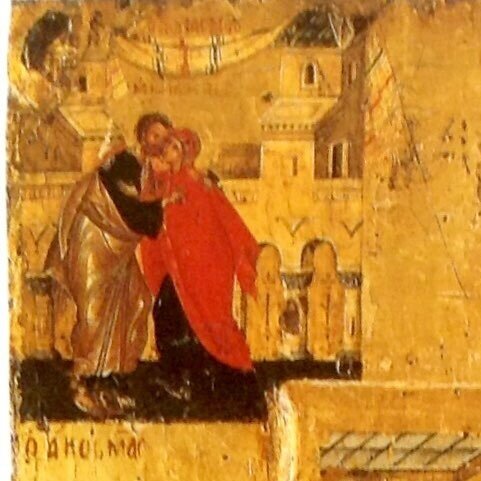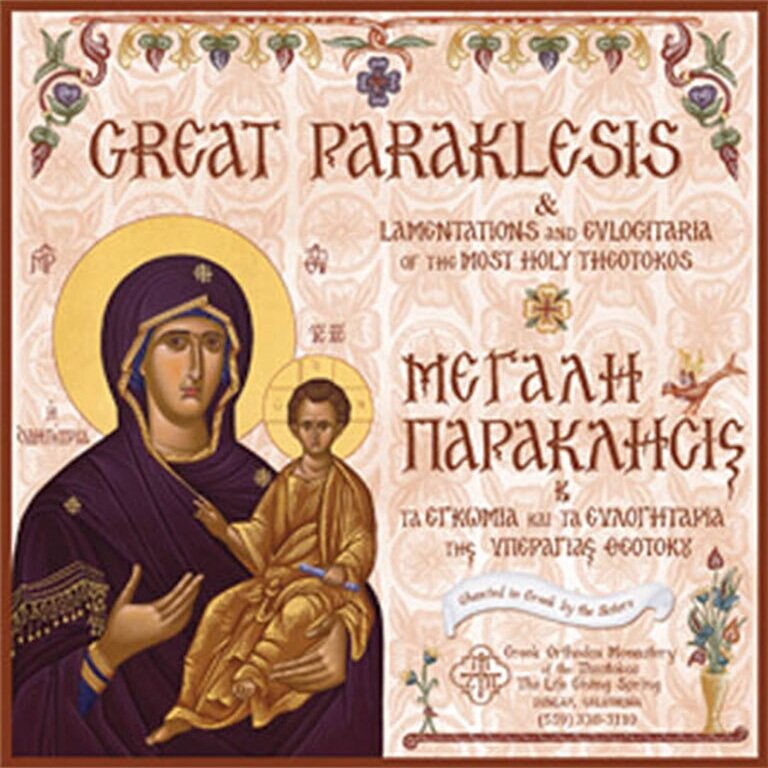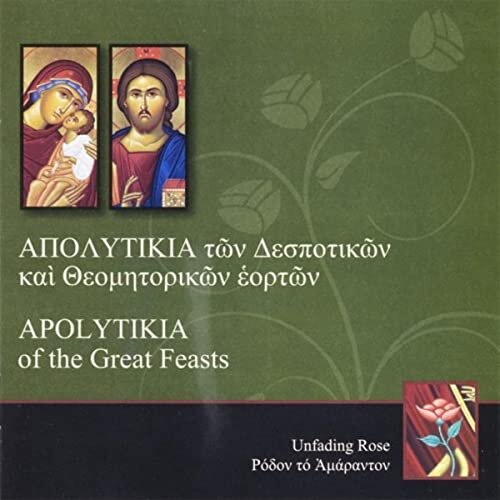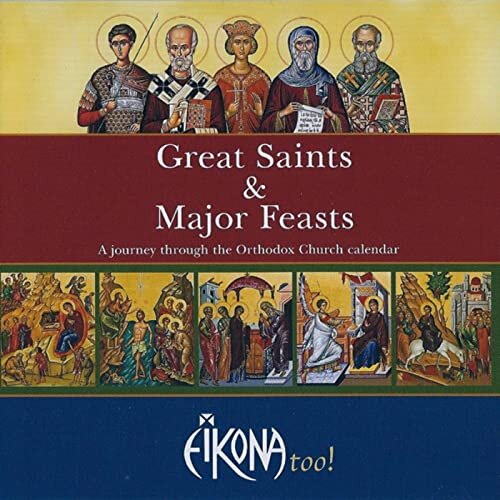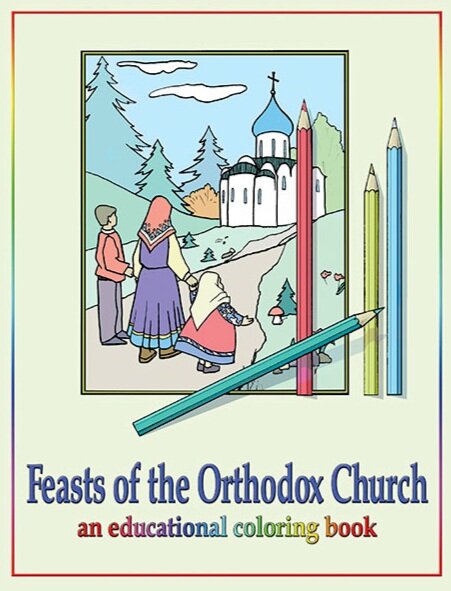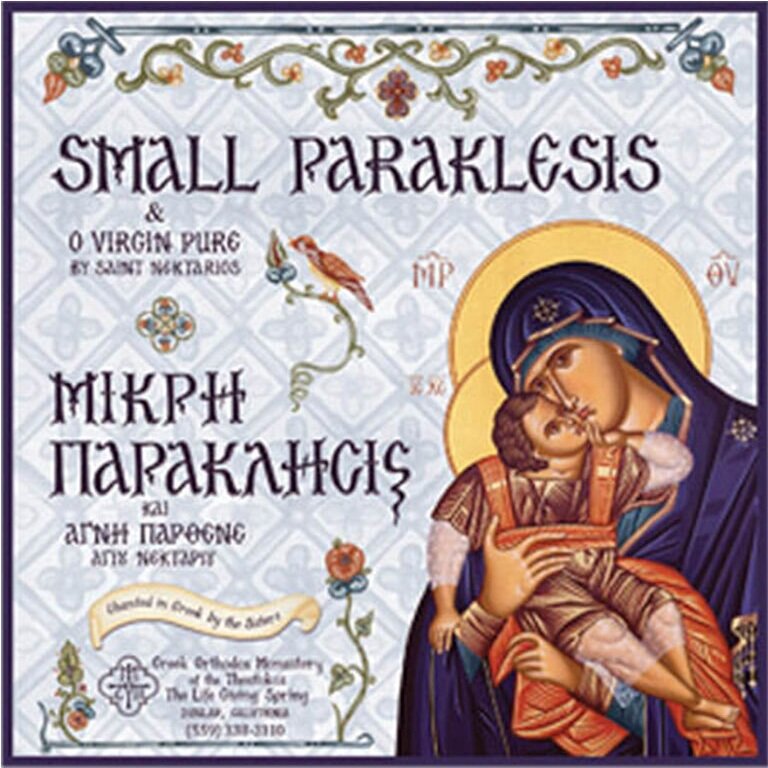Lesson for Children on the Dormition
© Copyright 2018 Saint Kosmas Orthodox Christian Education Association. All rights reserved. No part of this text may be reproduced, stored in a retrieval system, or posted on another website without permission of the copyright owner. Permission is granted to share this lesson only by sharing the link to this webpage.
The Dormition of the Most Holy Theotokos
Dear children — Let us listen and learn about the Dormition of the Mother of God.
Here in this icon we see the central figures present at the Dormition of the Mother of God.
Although the Dormition of the Mother of God is not recorded in the Scriptures, we know of her Dormition from Holy Tradition. As St. John writes at the end of his Gospel, "And there are also many other things... I suppose even the world itself could not contain the books that would be written." Holy Tradition carries equal weight with the Holy Scriptures. The Scriptures are actually just a part of Holy Tradition.
In the center we see her dead body. She died a natural death just like all men; her soul was separated from her body.
Her Son is there too, holding her most pure soul, in the form of an infant.
Above Christ we see a seraphim.
Christ has come, in His glory, accompanied by the angels, to receive the soul of His mother.
Around Panagia we see the apostles that have gathered there to be with her.
Holy Tradition tells us that four bishops were gathered there as well: St. Timothy, St. James, the brother of the Lord, St. Dionysios, and St. Hierotheos.
We recognize that they are bishops by the omophorions that they are wearing.
Here we see many more figures that were present at the Dormition.
We see many angels beside the bier of the Mother of God.
We see angels around Christ in His glory.
And we also see angels accompanying the Mother of God as she is ascending to heaven.
At the very top we see the angels opening the gates of heaven to her, as the hymnography of the feast exclaims the words from Psalm 23:7, "Let the gates be opened wide.. "
"The angels, as they looked upon the Dormition of the Virgin, were struck with wonder, seeing how the Virgin went up from earth to heaven."
—Megalynarion from Orthros of the Feast
"The dominions and the thrones, the rulers, the principalities, and the powers, the cherubim and the fearful seraphim glorify thy Dormition."
—third troparion from Vespers of the Feast
We also see in this icon how the disciples were miraculously brought in clouds to be near the Mother of God at her Dormition.
The Mother of God was central to the early Church, strengthening and guiding the disciples. All of the 12, except for Thomas, were brought here from different lands where they were preaching the Gospel.
Thomas, by Divine Providence, arrived three days later, but as we see in the icon above, he was blessed to see her ascending and to receive her belt. A holy section of this belt still exists today at the monastery of Vatopaidi, on Mt Athos.
St. Thomas was miraculously brought in a cloud from India where he had been preaching the Gospel. He was sad to find out that he had arrived three days late. To comfort him, the other apostles brought him to where Panagia had been buried. Some are covering their noses, expecting the smell of a body that would have started to decompose. But when they opened the grave, they saw that her body was gone, and understood that her body had ascended.
"Neither the tomb nor death had power over the Theotokos... For as the Mother of Life she has been transported into Life by Him Who dwelt in her ever-virgin womb."
—from Orthros of the Feast
In this icon of the feast, we see a multitude of angels coming down from heaven... hosts of angels and archangels and all the heavenly powers, accompanying Christ, the King of Glory, and approaching his immaculate Mother.
We notice, too, in the icon that St. Peter is at the head of the body of the Theotokos, and that St. Paul is at her feet.
Again we see her soul as an infant, and the hands of Christ are covered out of respect for the purity of her soul. With sweet hymns the heavenly hosts accompanied her soul as it went up in the arms of the Lord.
According to the Protoevangelion of James, the body of the Mother of God was carried in procession to the Garden of Gethsemane for burial. Angelic singing could be heard as a bright radiant cloud accompanied the procession. The Jews hated seeing this. The Theotokos was a reminder of her Son who they had crucified.
One of the Jewish priests named Iephonias rushed with fury and attempted to overturn the bier carrying the body of Panagia. Immediately an angel appeared and cut off his hands, leaving them hanging on the bier. He immediately repented, his arms were completely restored, and he became a Christian.
See here too how the iconographer attempts to convey the radiance of the Glory of Christ in layers.
Do you see the wings on the soul of Panagia? The wings show how the soul is able to freely move about, now that it is separated from the body.
Do you see the apostle by the feet of Panagia, next to St. Paul, with his hands raised? These hands are expressing the hymnography of the feast, "O marvelous wonder! The source of Life is laid in the tomb, and the tomb itself becomes a ladder to heaven."
Do you see how her tomb became a ladder to heaven? By dying she has risen to live in the heavenly abodes, eternally with her Son.
Different regions of the Orthodox world sometimes developed somewhat different styles of iconography. This icon from Cyprus has more vivid shades of red and blue.
Again we see that St. Peter is at her head, and St. Paul at her feet.
We see here how sorrowful the disciples are, that they will no longer see their Mother and comforter.
Who would counsel them in their many temptations, and encourage them in their afflictions?
Seeing the sorrow of the disciples, the Mother of God encouraged them before her departure, telling them that she would be with them as an intercessor, just as she had been on earth.
Do you remember this first miracle of Christ, at the wedding of Cana?
Christ and His Mother had been invited to this wedding. When the wine ran out, Panagia asked Christ to help them.
Although we see Christ rebuking his mother in this icon, because he had not planned to perform his first miracle there, at the same time he has told the servants to fill the vessels with water and blesses the water to become wine.
In the same way Panagia interceded here at the wedding feast, she will always intercede for all who honor her and call upon her for help.
Three days after her Dormition, after her disappearance from the tomb, the Mother of God appeared to the disciples while they were gathered together for a meal.
Since the Lord’s Ascension, it had been their custom at each meal to set aside a portion of bread for Christ, and after the prayers at the conclusion of the meal, to lift up this portion and say, “Great is the Name of the Lord! Oh Lord Jesus Christ, help us!”
When they had finished the meal and were about to do this, they suddenly heard angelic singing and saw the Mother of God in a bright light standing in the air, surrounded by angels. She said to them, “Rejoice, for I am with you all the days of your lives!” With joy, the apostles exclaimed, “All-Holy Mother of God, save us!”
Since then it has been the custom in many monasteries to set aside a portion of bread for Panagia and after the prayers following the meal to carry this "Panagia" bread around so everyone assembled can take a piece of it.
This icon of the Dormition also shows scenes from the life of the Mother of God.
In the upper left corner we see her parents Joachim and Anna, embracing. This shows the Orthodox teaching that Panagia was conceived in a manner like all men, born with ancestral sin. Being a carrier of this sin, she had to die in the same manner as all men.
In contrast to Orthodox Tradition, the Roman Catholic teaching which became dogma in 1854, is that the Mother of God was born without this ancestral sin. This heretical teaching would separate her from the human race. As a result, in 1950 the dogma was added that Mary did not have a physical death, but was "assumed" into heaven. The Fathers of the Orthodox Church teach that the Mother of God was born with the ancestral sin, but through her great personal struggle and the grace of God she was able to reach the state that Adam had before the Fall, and then even higher, higher than the angels.
In the upper right corner of the icon we see the Nativity of the Theotokos, which the Church celebrates on September 8th.
In the lower left corner of the icon the priests are blessing her.
And in the lower right corner of the icon, we see her Entrance into the Temple, which the Church celebrates on November 21st.
All these events in her life are part of the Holy Tradition of our Church.
On the left side of the icon we see a full-body icon of St. Cosmas the Melodist.
And on the right side, St. John of Damascus.
At the top of the icon is St. Joseph the Hymnographer.
And at the bottom is St. Theophanes.
These four saints—St. Cosmas the Melodist, St. John of Damascus, St. Joseph the Hymnographer, and St. Theophanes—wrote many homilies and canons for the feasts of the Mother of God.
This is an icon from the Holy Monastery of Great Meteoro.
We see how the Mother of God, as the Queen described in Psalm 44, will be interceding for us up to and even at the Final Judgment.
Christ is on the throne as Judge.
The words on the Gospel that Christ is holding, are:
«δεῦτε οἱ εὐλογημένοι τοῦ Πατρός μου κληρονομήσατε τὴν ἡτοιμασμένην ὑμῖν Βασιλείαν.»
“Come, ye who are blessed of My Father, inherit the kingdom which has been prepared for you.”
On the scroll of the Theotokos we read the following dialogue, with the words of Panagia in black and the words of Christ in red.
The Panagia says:
«-Δέξαι δέησιν τῆς σῆς μητρός, οἰκτίρμον.
“Receive the supplication of Your Mother, O Merciful One.
Our Lord Jesus Christ responds:
-Τὶ μῆτερ αἰτᾶς;
What, Mother, are you asking?
Panagia:
-Τὴν βροτῶν σωτηρίαν.
The salvation of mankind.
Christ responds:
-Παρώργισάν με.
They have aroused my wrath.
Panagia:
-Συμπάθησον, Υἱέ μου.
Have sympathy, my Son.
Christ:
-Ἀλλ’οὐκ ἐπιστρέφουσιν.
But they are not returning (repenting).
Panagia:
-Κύριε, σῶσον χάριτι.
Lord, save them by Your grace.
Christ:
-Ἕξουσι λύτρον.
They will have deliverance.
Panagia:
-Εὐχαριστῶ Σοι, Λόγε.»
I thank You, O Word.”
O you Apostles from afar, being now gathered together here in the village of Gethsemane, lay my body in burial; and You, my Son and my God, receive my spirit.
You are the sweetness of Angels, the gladness of afflicted ones, and the protectress of Christians, O Virgin Mother of our Lord; be my helper, and save me from out of eternal torments.
I have you as Mediatress with the man-befriending God; may He not censure my actions before the hosts of the Angels. I supplicate you, O Virgin, come to my aid most quickly.
You are a gold-entwined tower and a twelve-wall encircled city, a shining throne touched by the sun, a royal chair of the King, O unexplainable wonder! You that milk-feed the Master.
The hymn calls her a twelve-walled encircled city because the protection of the Mother of God is like the fortified walls around a city, Constantinople being an example of the first Christian city (with walls encircling it) that was dedicated to her. The number 12 is a number which expresses completeness and perfection, in the Old and New Testaments and in the Holy Tradition of our Church.
"In giving birth, you retained your virginity; in falling asleep you did not forsake the world, O Theotokos. You were translated to life, O Mother of Life, and through your intercessions you deliver our souls from death."
—Apolytikion of the Feast
THE END AND GLORY TO GOD FOR ALL THINGS!
© Copyright 2018 Saint Kosmas Orthodox Christian Education Association. All rights reserved. No part of this text may be reproduced, stored in a retrieval system, or posted on another website without permission of the copyright owner. Permission is granted to share this lesson only by sharing the link to this webpage.
View More Lessons:
Return to DORMITION Home Page
Hymnography Resources for Dormition
PRINTABLE SHEET MUSIC AND LITURGICAL TEXTS WITH SAMPLE AUDIOS:
Saint Anthony’s Greek Orthodox Monastery
Divine Music Project
AGES Initiatives, Inc.
Digital Chant Stand
AUDIO RECORDINGS OF THE HYMNS FOR THE FEAST:
Unfading Rose
Apolytikia of the Great Feasts
Audio MP3 Album from Amazon (English & Greek)
Eikona
Great Saints & Major Feasts
Audio MP3 Album from Amazon (English)
Our Great Intercessor: The Small & Great Paraklesis and the Lamentations of the Panagia
This book partners with two cds of the same titles, (1) and (2), chanted by the sisterhood of the Life-Giving Spring Monastery. The Lamentations of the Panagia are chanted in this monastery annually during the vigil of the Dormition. Children can learn much about the Panagia by reading the hymnography in this beautiful, full-color book. The chanting on the cds is in Greek, but the book contains the words in both Greek and English.
Greek Orthodox Monastery of the Theotokos the Life Giving Spring
Audio Recordings of the Hymns for the Feast
AUDIOS COURTESY OF
MASTER CHANTER, DIMITRIOS KATSIKLIS
Apolytikion
In giving birth, thou didst preserve thy virginity; in thy dormition, thou didst not forsake the world, O Theotokos. Thou wast translated unto life, since thou art the Mother of Life; and by thine intercessions dost thou redeem our souls from death.
Kontakion
The grave and death could not hold the Theotokos, who is unsleeping in her intercessions and an unfailing hope in her mediations. For as the Mother of Life she was translated to life by Him Who dwelt in her ever-virgin womb.
Sticheraric Apolytikio of the Dormition of the Theotokos
CDs and Digital music for purchase
Return to DORMITION Home Page
Scripture — Dormition
Books for Children — Dormition
Rejoice, Panagia (English)
Rejoice, Panagia (Greek)
Greek Orthodox Monastery of the Theotokos the Life Giving Spring (2014)
Paterikon for Kids #23: Dormition of the Theotokos (English, Greek, Romanian)
My Book of Church Feasts (English, Greek)
The Life of the Theotokos (English, Greek, Romanian)
My Synaxarion: August (English, Greek)
Orthodox August Package (English, Greek)
Egle-Ekaterine Potamitis
Potamitis Publishing
Feasts of Christ and the Theotokos and Miracles of the Lord
Book 1 (in a series of 8)
by Spiritual Fragrance Publishing (2012)
distributed in the US by Archangels Books
Heaven Meets Earth: Celebrating Pascha and the Twelve Feasts
John Kosmas Skinas
Ancient Faith Publishing (2015)
Feasts of the Orthodox Church
Anna Larsen
Anna Larsen Books (2013)
Our Great Intercessor: The Small & Great Paraklesis and the Lamentations of the Panagia
This book partners with two cds of the same titles, (1) and (2), chanted by the sisterhood of the Life-Giving Spring Monastery. The Lamentations of the Panagia are chanted in this monastery annually during the vigil of the Dormition. Children can learn much about the Panagia by reading the hymnography in this beautiful, full-color book. The chanting on the cds is in Greek, but the book contains the words in both Greek and English.
Greek Orthodox Monastery of the Theotokos the Life Giving Spring
The Life of the Virgin Mary, the Theotokos
Holy Apostles Convent (1989)
The Law of God: An Introduction to Orthodox Christianity
Fr. Daniel Sysoev
Daniel Sysoev Inc. (2016)
The Illustrated Synaxarion of the Orthodox Church
compiled by Antonios Markou
published in English in 2004, in Athens, Greece
currently out of print
Return to DORMITION Home Page
Coloring Pages — Dormition
from Feasts of the Orthodox Church educational coloring book by Anna Larsen
Coloring Pages copyright: © 2013 Anna Larsen Books. All rights reserved. Posted on SaintKosmas.org with permission. Permission is granted to make copies of these coloring pages for non-commercial purposes.
CLICK THE IMAGE TO DOWNLOAD A PDF OF THE COLORING PAGE.
Return to DORMITION Home Page
Audios — Dormition
Audio Recordings of the Hymns for the Feast
CDs and digital music for Purchase
Audio Synaxarion
Patristic Nectar Synaxarion Project
Log on to Patristic Nectar to hear the Synaxarion reading for any day of the year - for free!
Audios of Sermons on the Dormition
On the Dormition of the Mother of God
Fr. Demetrios Carellas
Saint Nicholas Ranch, Dunlap, California
Bright Week, 2017
The Worthiness of the Most Holy Theotokos
By Geronda Ephraim of Arizona as narrated by Constantine Zalalas
Return to DORMITION Home Page
Videos — Dormition
Message About Additional Orthodox Education Resources
If you are aware of any additional Orthodox education resources for children related to the Dormition, please send us the resource name and internet link via our CONTACT US page. Thank you!
Return to DORMITION Home Page
Fair Use Statement
This site may contain copyrighted material the use of which has not always been specifically authorized by the copyright owner. We are making such material available in an effort to advance understanding of environmental, political, human rights, economic, democracy, scientific, and social justice issues, etc. We believe this constitutes a ‘fair use’ of any such copyrighted material as provided for in section 107 of the US Copyright Law.
In accordance with Title 17 U.S.C. Section 107, the material on this site is distributed without profit to those who have expressed a prior interest in receiving the included information for research and educational purposes. For more information go to: http://www.law.cornell.edu/uscode/17/107.shtml
If you wish to use copyrighted material from this site for purposes of your own that go beyond ‘fair use’, you must obtain permission from the copyright owner.
Return to DORMITION Home Page
















